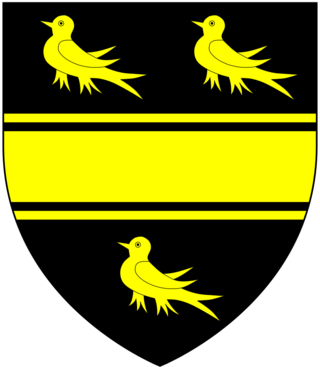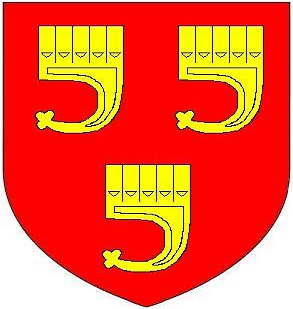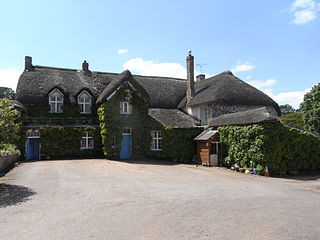
Thomas Herbert, 8th Earl of Pembroke and 5th Earl of Montgomery,, styled The Honourable Thomas Herbert until 1683, was an English and later British statesman during the reigns of William III and Anne.

Earl of Mount Edgcumbe is a title in the Peerage of Great Britain. It was created in 1789 for George Edgcumbe, 3rd Baron Edgcumbe. This branch of the Edgcumbe family descends from Sir Piers Edgcumbe of Cotehele in Cornwall, who acquired an estate near Plymouth through marriage in the early 16th century, which was later re-named "Mount Edgcumbe". His descendant Richard Edgcumbe was a prominent politician and served as Paymaster-General of Ireland and as Chancellor of the Duchy of Lancaster. In 1742, he was created Baron Edgcumbe, of Mount Edgcumbe in the County of Devon, in the Peerage of Great Britain. Richard Edgcumbe was succeeded by his eldest son, the second Baron. He represented Plympton Erle, Lostwithiel and Penrhyn in the House of Commons and served as Lord-Lieutenant of Cornwall. On his death, the title passed to his younger brother, the third Baron. He was an Admiral of the Blue and also held political office as Treasurer of the Household and as Captain of the Honourable Band of Gentlemen Pensioners. In 1781, he was created Viscount Mount Edgcumbe and Valletort and in 1789 he was further honoured when he was made Earl of Mount Edgcumbe. Both titles are in the Peerage of Great Britain.

Baron Arundell of Wardour, in the County of Wiltshire, was a title in the Peerage of England. It was created in 1605 for Thomas Arundell, known as "Thomas the Valiant", son of Sir Matthew Arundell and grandson of Sir Thomas Arundell and of Margaret Howard, a sister of Queen Catherine Howard. Arundell had already been created a Count of the Holy Roman Empire by Rudolph II in December 1595. He was succeeded by his son, the second Baron. He fought as a Royalist in the Civil War and was mortally wounded at the Battle of Stratton in 1643. His son, the third Baron, was implicated in the Popish Plot and imprisoned in the Tower of London for six years. However, after the accession of James II he was restored to favour and served as Lord Privy Seal from 1687 to 1688. His great-great-great-grandson, the eighth Baron, was an avid collector of art and accumulated immense debts in building and furnishing New Wardour Castle.

Trerice is an historic manor in the parish of Newlyn East, near Newquay, Cornwall, United Kingdom. The surviving Tudor manor house known as Trerice House is located at Kestle Mill, three miles east of Newquay. The house with its surrounding garden has been owned by the National Trust since 1953 and is open to the public. The house is a Grade I listed building. The two stone lions on the front lawn are separately listed, Grade II. The garden features an orchard with old varieties of fruit trees.

John Arundell, Esquire, of Trerice in Cornwall, later given the epithet "Jack for the King", was a member of an ancient Cornish gentry family, who as a Royalist during the Civil War served King Charles I as Governor of Pendennis Castle, Falmouth. In 1646 he retained the castle in a heroic manner during a five-month-long siege by Fairfax, during which his forces were reduced by hunger to eating their horses, and finally achieved an honourable surrender

John Arundell of Trerice (1613–1644) was a landowner from Cornwall who sat in the House of Commons from 1640 to 1644. He supported the Royalist cause during the First English Civil War and was killed during the Siege of Plymouth in November 1644.

Sir John Arundell (1495–1561), of Trerice, Cornwall, nicknamed "Tilbury Jack", was a commander of the Royal Navy during the reigns of Kings Henry VIII and Edward VI and served twice as Sheriff of Cornwall.

John Arundell, of Trerice in Cornwall, was a Member of Parliament for Mitchell, Cornwall, in 1555 and 1558, and was High Sheriff of Cornwall in 1573–1574.

Richard Arundell, 1st Baron Arundell of Trerice of Trerice in Cornwall, was an English politician who sat in the House of Commons at various times between 1640 and 1664 when he was raised to the peerage. He fought in the Royalist army during the First English Civil War.

John Arundell, 2nd Baron Arundell of Trerice of Trerice, Cornwall, was an English politician who sat in the House of Commons at various times between 1666 and 1687 when he inherited his peerage.
The Governor of Pendennis Castle was a military officer who commanded the fortifications at Pendennis Castle, part of the defences of the River Fal and Carrick Roads, on the south coast of Cornwall near Falmouth. Originally fortified under Henry VIII, defences in the area were intermittently maintained until after the Second World War. The office of governor was abolished in 1837, when Gen. Anderson received the colonelcy of the 78th Regiment of Foot.

Sir Thomas Grenville II, K.B.,, lord of the manors of Stowe in Kilkhampton, Cornwall and Bideford, Devon, Sheriff of Cornwall in 1481 and 1486. During the Wars of the Roses, he was a Lancastrian supporter who had taken part in the conspiracy against Richard III, organised by the Duke of Buckingham. On the accession of King Henry VII (1485–1509) to the throne, Sir Thomas was appointed one of the Esquires of the Body to Henry VII. On 14 November 1501 upon the marriage of Prince Arthur to Katherine of Aragon, he was created a Knight of the Bath. He served on the Commission of the Peace for Devon from 1510 to his death in circa 1513.

Sir George Smith of Madworthy-juxta-Exeter and Madford House, Exeter, Devon, was a merchant who served as MP for Exeter in 1604, was three times Mayor of Exeter and was Exeter's richest citizen, possessing 25 manors. He was the grandfather of George Monck, 1st Duke of Albemarle (1608-1670) KG and of John Grenville, 1st Earl of Bath (1628–1701).

The manor of Bideford in North Devon was held by the Grenville family between the 12th and 18th centuries. The full descent is as follows:

The Arundell family of Cornwall are a Cornish family of Norman origin.

Spencer Combe in the parish of Crediton, Devon, is an historic estate. The grade II listed farmhouse known today as "Spence Combe", the remnant of a former mansion house, is situated 3 miles north-west of the town of Crediton.

John Arundell, 3rd Baron Arundell of Trerice of Trerice, Cornwall, who inherited his peerage on the death of his father in 1698.

John Arundell, 4th Baron Arundell (1701-1768) of Trerice, Cornwall, inherited his peerage on the death of his father in 1706. He was the last Baron Arundel of Trerice since he had no heir upon his death and the title ultimately passed to Sir Thomas Dyke Acland.

Painsford is an historic estate in the parish of Ashprington in Devon.

Barbara Herbert, Countess of Pembroke was a British court official and noble, the second wife of Thomas Herbert, 8th Earl of Pembroke. She became Lady of the Bedchamber for Princess Caroline of the Royal House of Hohenzollern.













